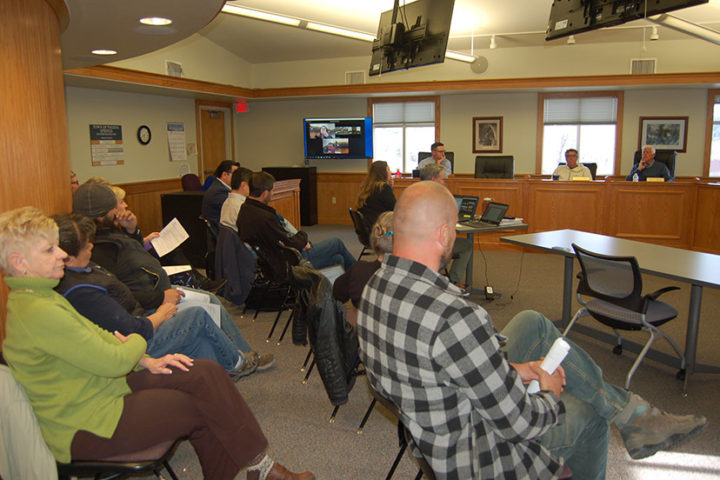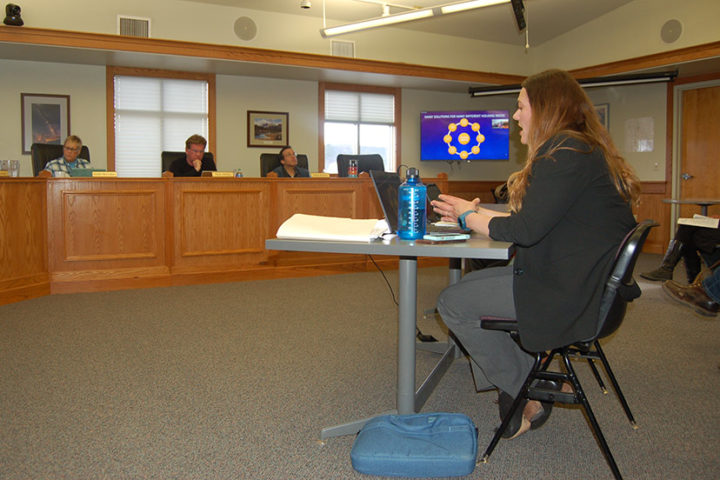PHOTO: Andrea Phillips, Pagosa Spring Town Manager, summarizes the recent steps taken by the municipal government to address the housing crisis in Archuleta County.
Last night’s April 12 Planning Commission meeting, at the Pagosa Springs Town Hall, attracted a decent audience, many of whom stood up at the start of the meeting to publicly encourage the creation — through government involvement — of more workforce housing.

Which happened to be the subject of three proposals awaiting the Commission’s possible approval: a “P3” public-private partnership between the Town government and Texas-based Servitas, a company that specializes in the development of student housing — and maybe, moving forward, in the development of workforce housing.
All three proposed housing developments would be located along or near Apache Street, at the south end of downtown Pagosa Springs, within easy walking distance of the High School, the Town Hall, Yamaguchi Park, Seeds of Learning Early Childhood Center, and the Aspire pregnancy support center. To mention a few nearby amenities.
Among the people who addressed the Commission in an encouraging manner, at the beginning of the meeting: Dr. Rhonda Webb, CEO of the Pagosa Springs Medical Center; Mary Jo Coulehan, Executive Director for the Pagosa Springs Chamber of Commerce; County Commissioner candidate Veronica Medina; local developer Andre Redstone; Emily Lashbrooke, Executive Director of the Community Development Corporation.
Sort of a ‘Who’s Who’ of our community leadership, you might say.
Here’s a sample of the testimony, from Dr. Webb’s short speech about the employee crisis in the health care industry, locally and nationally.
“We are having a tremendous amount of problems hiring people. There are many reasons for that, in health care; part of it is that many people have quit health care, because of the pandemic.
“But having housing for our workforce is key for us. For paramedics, for nurses. Every week, we have someone turn down a job offer because they just can’t find afford to live here. So…”
Dr. Webb let her voice trail off, but her meaning was clear. Our community needs to find ways to combat the greed and selfishness that is driving American housing markets into the stratosphere and causing people to turn down jobs at the hospital, at the water district, at the County jail, at the police department, at our retail stores and restaurants… because they can’t afford to live here…
Can a little, rural town like Pagosa Springs actually fix this problem?
Do we need to look to folks from Texas — folks like Servitas — to help solve this problem?
Here are a few words from developer Andre Redstone’s testimony, addressing the six commissioners seated on the dais.
“I would assert, based upon personal experience, and being at the cusp of offering an initiative specifically geared toward the manufacture of attainable and affordable workforce housing. We’ve worked our system; we continue to work our program; we continue to work our team. But under the auspices of collaboration, we haven’t been invited into the inner circle to talk about it.
“So that speaks to an opportunity, a mutually reciprocal opportunity, that we as the private sector may need to do more, to open ourselves up and engage.
“Conversely, there’s an opportunity for our local leadership to do more, to actually engage with us.
“I look forward to that collaboration with you, and the important role that you serve…”
Mr. Redstone wasn’t the only member of the audience to suggest that our local construction industry needs to become more involved in repairing a broken housing and real estate market seriously skewed towards expensive, high-end homes and vacation rentals.
We then heard, from Town Manager Andrea Phillips, a lengthy overview of the crisis, and the Town governments past and future role in addressing the problem.

In my opinion, the Town government has been much more active, and innovative, than our County government — in their attempts to earnestly tackle housing inequity. The three proposed Apache Street projects, that have been negotiated with Texas-based Servitas over the past six months, are far and away the most ambitious workforce housing projects I’ve heard about.
64 units of one-bedroom and two-bedroom apartments, as proposed, would total more multi-family housing units than have been built in Pagosa over the past 20 years.
The focus on smaller, one-bedroom units — 42 of the 64 units are one-bedroom in the current plans — are a reflection of a couple of demographic trends in America, and worldwide.
Young people entering the workforce are most likely to be unmarried, and have no children.
According to a recent report by MAST Center Research, the age at first marriage has reached a historic high in the U.S., echoing a steady increase over the past several decades. The median age at first marriage in 1970 was about 23 for men and 21 for women… compared to about 30 for men and 28 for women in 2018.
As the age at ‘first marriage’ has risen, the proportion of young people under the age of 24 who are married has declined. In 1968, about 40 percent of young adults ages 18 to 24 lived with a spouse, compared to just 7 percent in 2018.
At the some time (and no doubt partly as a result of the reluctance to get married) the birth rate in America has been dropping, over the past decade.
The recently released official U.S. birth data for 2020 showed that births have been falling almost continuously for more than a decade. For every 1,000 women of childbearing age (15 to 44), 56 of them gave birth in 2020, compared to 70 in 2007… a 20 percent decline. The “total fertility rate” — an estimate of the average total number of children a woman will ever have — fell from 2.12 in 2007 to 1.64 in 2020.
The rates have fallen even further, I understand, as the pandemic has rolled on.
The total fertility rate is now well below 2.1, the value typically considered to be “replacement fertility” — the rate needed for the population to replace itself without immigration.
Meanwhile, total annual immigration into the U.S. has also crashed since the beginning of the Trump administration.
Hence, the need for one-bedroom apartments, for unmarried, childless young people.
The question of most interest to this reporter, during Tuesday’s debate, was:
‘How much will Servitas end up charging for rent, for a new one-bedroom apartment?’
Because… well, isn’t that the key number, during a workforce housing crisis?

